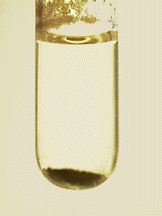|
Introduction Many of the concepts used in this experiment, including limiting and excess reagents, moles, and theoretical yields are covered extensively in your textbook. Since the treatment is extensive, another deep discussion here would be redundant. So we will just hit the highlights. Limiting and Excess Reagents The concept of limiting and excess reagents, deals with how much product is produced when two or more reactants are mixed. Whether you realize it or not, this concept possesses very practical applications in the real world. For example, in the business of making a chemical product of some kind, it is important to do it as efficiently and with as little waste as possible. This is also true in the laboratory, where you want to use only the amounts of reactants necessary to produce the largest amount of product, as anything more would be simply wasted. Consider a simple reaction where one mole of reactant A reacts with one mole of reactant B:
Now, if we added more of the limiting reagent, reactant B, more product results. Why, you may ask? Well reactant B limits how much product is obtained, thus when more B is added, the reaction will continue until one of the reactants is used up again. Therefore, one final question that exists is what is the most efficient mixture of these two reactants? In fact, the best mixture consists of exactly as much reagent A as reagent B that would allow for no reactants to be left over. Finding the Limiting Reagent For practice, let’s look at the following example and see if we can determine which reagent is limiting and which is in excess. Let's assume we have time-warped to the early 1970s where we all are employed by NASA as rocket scientists. We are working with a fuel mixture known to be composed of dinitrogen tetraoxide (N2O4) and hydrazine (N2H4). In further detail, these two reagents react to produce nitrogen gas (N2) and water vapor (H2O), as shown below, and we have been assigned the task to figure out which of our two reactants are limiting when 1.40-kg of N2H4 and 2.80-kg of N2O4 are allowed to react.
The first step is that we need a balanced equation:
Next, we have to see how many moles of one of the products is produced using stoichiometry. Let’s find the number of moles of H2O. Based on moles of Hydrazine (N2H4)
Theoretical and Percent Yields Now, let’s go ahead and take this one more step further. Assuming after further study, we found that this particular reaction was only 62.5% efficient. If this is the case, how much N2 gas is actually generated? In order to answer this problem, we have to use the limiting reagent we just calculated to figure out how many kilograms of nitrogen would be produced if the reaction was 100% efficient. 100% Efficiency
Now since we know the process is only 62.5% efficient, we can set up the following relation:
Rearranging, we can see that the actual yield in kilograms is going to be the theoretical yield multiplied by the percent yield (62.5%).
Thus, overall we only get 1.14-kg of nitrogen gas when we react 1.40-kg of hydrazine! Precipitation In this experiment, a reaction between the two aqueous reagents copper (II) nitrate, Cu(NO3)2, and potassium iodide, KI, will form a precipitate. The same word meteorologists use when talking about falling rain and snow, a precipitate in a scientific sense is the solid formed during a reaction between two aqueous compounds. In order to better separate the solid and liquid phases, the test tubes are placed in a centrifuge. Spinning them around at an extremely high velocity, the centrifuge will force the heavier precipitate to the bottom of the test tube. At the end of centrifugation, a solution that went into the test tube cloudy becomes crystal clear with a solid accumulated at the bottom of the tube . The clear liquid found above the precipitate is called the supernatant, and in this experiment, we will be testing the supernatant to see which of the reactants remains after the reaction is complete. In other words, whichever reactant is present in the supernatant once the reaction stops is obviously in excess, and is our excess reagent, while the reactant not detected in the supernatant was completely used and is in fact our limiting reagent. This can be verified by adding more of the two solutions we are studying. Using our example earlier, if more solution A is added and more precipitate forms, then reagent A is the limiting reagent. Similarly, if more solution B is added and more precipitate forms , then reagent B is the limiting reagent. The Reaction in the Experiment Specifically, this experiment will involve taking aqueous solutions of Cu(NO3)2 and KI and allowing the two solutions to react as shown:
Therefore, a reaction between 0.50-M Cu(NO3)2 and 0.50-M KI, now has a little more meaning to us. In the experiment, each student will be assigned different volumes of reactants to investigate. Based on the volume of reactants assigned, a theoretical amount of product should be calculated. Once the experiment is actually performed and these volumes of reactant combined, the precipitate is recovered and its mass determined. The final step in the process will be to evaluate the overall efficiency of this particular reaction by reporting the percent yield of the reaction based on your and the class' experimental results.
|
 |
Limiting and Excess Reagents





